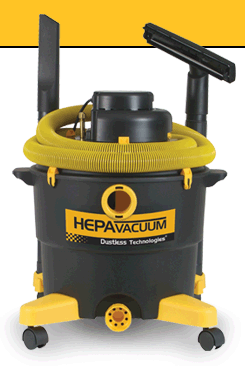
EPA
Renovation Repair and Painting
Lead Certification Course
Contact:
Tony CalistroRing's End, Inc.
tony_calistro@ringsend.com
203-814-3024
Where
Ring's End Learning Center
160 Avon Street
Stratford, CT 06615
Driving Directions
-
Meets EPA requirements for lead-safe certification
-
Certified HEPA rated filter Vacuum is certified for air-tightness
-
Micro-prefilter extends life of the HEPA filter
-
Can switch from dry operation to wet without stopping
-
Approved for hazardous materials such as lead and asbestos
-
3 year warranty

New EPA law applies to both exterior and interior renovations
Few will argue that lead is toxic and that dust from sanding, cutting, or otherwise disturbing lead paint can cause health problems both for children coming in contact with it and for workers creating the dust when renovating older housing. Most professional contractors are aware of the hazards and take appropriate precautions. But beginning in 2010, federal law requires contractors to be trained and certified under the U.S. Environmental Protection Agency's 2008 Lead Renovation, Repair, and Painting Program. Any renovation activity that disturbs at least 20 square feet of lead paint on the outside, or 6 square feet on the inside of a house, school, or child-care facility built before 1978 will be subject to the regulations in the EPA program.
EPA pamphlet
In fact, one provision of the Lead Renovation, Repair, and Painting Program has been in effect since December 2008. It requires contractors, before starting any work on pre-1978 housing and child-occupied facilities, to give property owners and occupants the EPA pamphlet Renovate Right: Important Lead Hazard Information for Families, Child Care Providers, and Schools. (That pamphlet is available at all Ring's End Locations.) Contractors also must document their compliance with this requirement and keep a record of it for three years. The program's provisions went into effect on April 22, 2010. Contractors have to follow EPA-prescribed lead-safe work practices; and company certification, employee training and additional recordkeeping requirements. Two pamphlets designed to help contractors comply with the new rules - Small Entity Compliance Guide to Renovate Right and Lead Safety During Renovation are available free at the EPA's Web site.
Company certification
All firms (including self-employed contractors) working on pre-1978 housing will be required to be certified by the EPA. Firms began applying to the EPA for certification on October 22, 2009, by submitting an "Application for Firms," available from this office by contacting Tony Calistro at tony_calistro@ringsend.com
Employee training
In each firm, at least one employee will need to become a "certified renovator." This entails taking an eight-hour "Renovator Initial Training Course" from an EPA-, tribal-, or state-accredited trainer and earning a course completion certificate (a copy of which certified renovators will have to carry at any applicable job site).
At least one certified renovator will have to oversee the job site to ensure compliance with RRP rules. This person will be responsible for testing for lead and containing and cleaning the work area, as well as training other workers in any lead-safe practices that apply to their assigned activities.
Recordkeeping
Contractors will need to keep records for three years showing compliance with the Lead Renovation, Repair, and Painting Program. The EPA has posted a sample recordkeeping checklist on its Web site. Examples of required records include lead-paint testing results, documentation that the EPA pamphlet was delivered, and documentation of lead-safe work practices.
Exterior lead-safe practices
The Lead Renovation, Repair, and Painting Program stipulate lead-safe work practices for both interior and exterior renovations. Exterior contractors who will be disturbing 20 square feet of lead paint need to close doors and windows within 20 feet of the work. If there are any doors in the work area that will be used during the course of the job, they should be covered with plastic so workers can use them without allowing dust and debris through. For at least 10 feet beyond the work area in all directions - or farther, if necessary - the ground has to be covered with plastic to collect paint debris. Vertical containment is required when the work area is close to other buildings or in windy conditions. At the end of the job, the work area has to be thoroughly cleaned, and all waste needs to be disposed of in such a way that the paint debris is contained.
Some states and localities have requirements for renovations on pre-1978 housing that are stricter than the EPA's. The National Lead Information Center (800/424-5323) is one source for information about state-specific lead-paint regulations.
For more detailed information see the following EPA web page:

